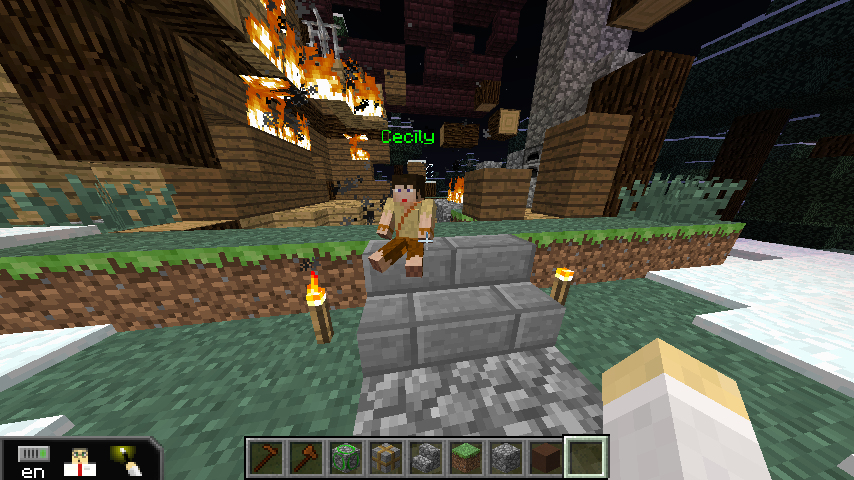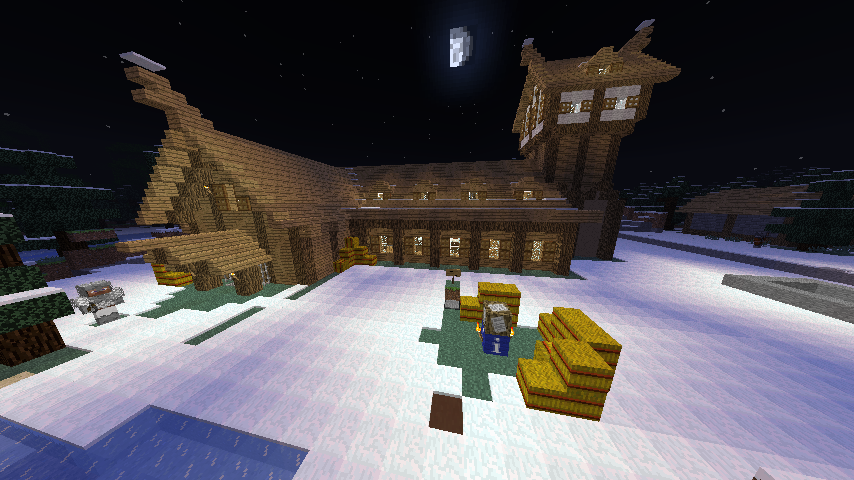I've been a teacher for over 20 years and I've never experienced a more successful unit than the one I'm about to describe.
My students struggle with reading and writing. It is very difficult for many of them as second language learners and for others for lack of enthusiasm or support at school and/or home. They are isolated learners who need something to write about that has meaning to them and we tend to drop the most unimaginitive prompts into their laps and expect them to care about what they put on paper.
I've recently developed a model that addresses literacy through Minecraft that has worked for me beyond my expectations and is motivating my students to read for understanding and enjoyment and write serious and highly creative narratives about their experiences with medieval history.
The outline for each 3-4 week unit is as follows:
Background information provided to students through slideshows, interactive media, and role-play at my direction (1 week).
Students complete one or more annotation exercises after reading a scene from an original story.
We play out the scene in Minecraft, complete with interactive characters, rewards, and imaginative role-play.
We each combine the original narrative with personal observations and discoveries with our interactions in the game to write a chapter of a historical novel.
Repeat until all objectives of the unit are met.
DETAILS
1. My good friend and author, Robert Walton, has created a series of short (250-350 word) vignettes that tell an incomplete story of a viking raid on England and its aftermath. [Sample]
2. As a class, we read each story and complete the interactive annotation exercise I've developed. I'm emphasizing identification of academic and content vocabulary, geographic and historical research, imagery, context clues, and decoding strategies in each document.
3. Students make a copy of each story, complete the assignment and turn it in to me. Successful completion earns them two wooden coins in the game that they will be able to use to buy items.
I use Google Docs for this, which helps me track progress AND provides students with access to amazing annotation and research tools within their document.
4. Students then login to Minecraft where I have recreated the setting of the vignette they have just read, complete with both familiar and new characters. The students interact with each non-player character (NPC) and learn more details and experience different perspectives about the scene which they record in their in-game diaries.
A few students have chosen to follow me in the game. I play on the screen and they give me advice on what to do and where to go. This group gathers information collaboratively and share it via Google Docs. We work on recording sensory details.
5. They exit Minecraft, we compare notes and observations and move on to the next reading and repeat until the entire scene has played out. In this Viking Age unit, the first scene consisted of one vignette. The second scene needed three vignettes to tell the story, and the final scene took two.
6. Once each scene was played out, we each wrote our versions of what we read and witnessed. I told my students that they are historical researchers gathering information and each of us (including myself) will be writing a book of historical fiction. The Viking Age will be covered in the first three chapters of that book.
I've outlined each "chapter" for them and have listed characters that they are required to write about, but they have the freedom to include a great deal of original ideas and descriptive details throughout. They are also challenged to link characters and events and write about motivation.
We will be learning history this way for the rest of the school year and at the conclusion, each of my kids will have a 40-50 page original "book" documenting the semester.
REFLECTION
Why has this been so successful? Several reasons pop into my mind.
They are truly interested in the storyline and really enjoy writing about their observations. Bob has done a brilliant job by creating vignettes that are original, contain historical references, and interesting dialogue at the ideal reading level.
There is an adventure element to it. I mean, who doesn't like a good adventure story? I've always challenged myself to create lessons that emphasize the narrative and this is a home run.
They are using their knowledge of vikings and applying it to their storytelling. I've read great descriptive passages that the kids have used to link characters all on their own.
It's intrinsically motivating. Although they are being rewarded extrinsically in game with tokens that they can use, I see more and more students now writing for the joy of it. Our writing time flies by and many are simply astonished at how many words they have typed.
The format allows for success of all. Even my most-challenged students are telling their stories and I think it is because they are comfortable with both the format and the learning environment. I love seeing this new confidence in them.
They get to use their imagination and write about their experiences. This has been my goal for my kids all year and I could not be happier at what is happening. My classroom building was recently made "more secure" by the addition of heavy gauge metal grills being riveted over our doors and windows - while we were in class writing. The kids didn't blink.
I must foster an environment of creativity and play in my classroom everyday.
NEXT STEPS
In the current unit, students are using some of the money and items they have earned for completing each previous assignment to buy materials and trade amongst themselves. Some students will soon advance, through experience earned in the game and through wealth accumulated, to a higher social rank and be granted land and titles from the king.
In upcoming units students will:
live and interact in a feudal village
add characters of their own and write dialogue
participate in the Third Crusade
help to build a cathedral while learning about the role of religion
become artists and scientists in Renaissance Italy
commission a ship and sail off to the new world
RESOURCES
Conquest texture/resource pack (optional, but very cool)
Multiple vignettes describing each scene, each including an annotation exercise. These are written by Robert Walton and I, please contact me if you are interested in them and I will share the folder with you.
Assorted schematics and original builds as needed to complete each scene.








